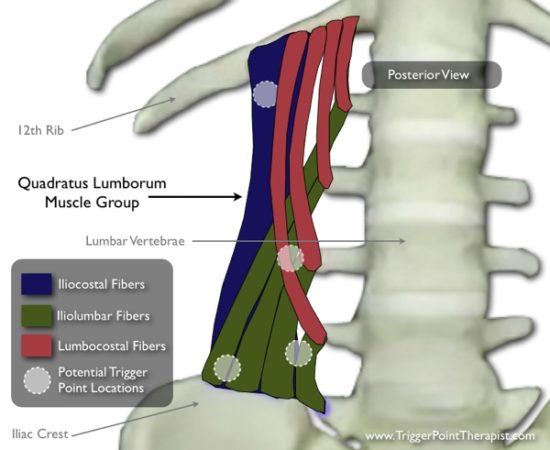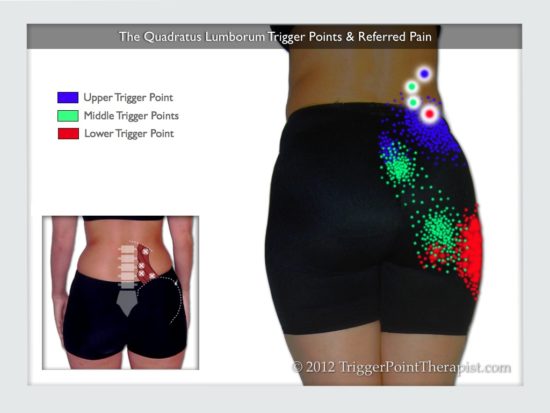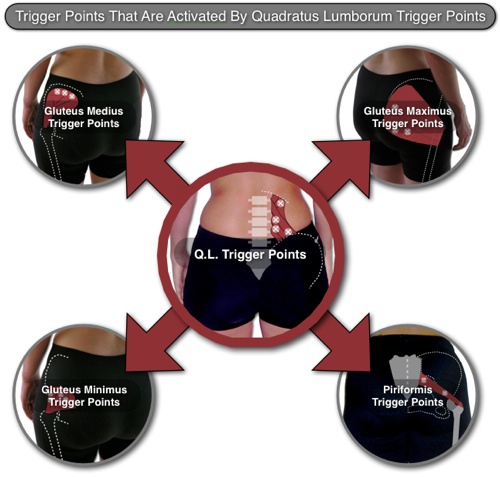Quadratus lumborum (QL) trigger points can play a prominent role in chronic low back pain.
The quadratus lumborum muscle
The quadratus lumborum muscle has a small and somewhat hidden muscle group that plays such a prominent role in normal body mechanics that without its functioning the upright posture of the human being is impossible to maintain.
- The iliocostal fibres (shown below in blue) attach on the iliac crest and run vertically upward to attach to the 12th rib.
- The iliolumbar fibres (shown below in green) attach on the iliac crest and run diagonally upward and medially to attach to the tranverse processes of the lumbar vertebrae (L1 to L4)
- The lumbocostal fibers (shown below in red) attach on the lumbar vertebrae and run diagonally upward and laterally to attach to the 12th rib.

The most important biomechanical consideration with the QL muscle relates to the guy-wire fibre arrangement discussed above. The primary antagonist to each QL muscle is the opposing QL muscle on the other side of the body. Thus, if one muscle develops trigger point activity, the muscle on the other side will become overloaded and develop trigger points as well.

The quadratus lumborum trigger points
As shown in the diagrams above, there are four potential trigger points in the QL muscle:
- The upper QL trigger point is found just lateral to where the lumbar paraspinal muscles and the 12th rib meet. Note: this trigger point lies underneath the paraspinal muscle mass in this region.
- The lower QL trigger point lies deep in the region where the paraspinal muscles meet the hip crest (iliac crest).
- The middle or deep QL trigger points lie closer to the spine than the superior or lower trigger points, next to the 3rd and 4th lumbar vertebrae.
- Typically, all four trigger points in this muscle present simultaneously.
Quadratus lumborum pain
The referred pain from the QL trigger points is usually described as an intense, deep ache, but it may also have a sharp, knife-like quality at times, particularly during movement. The distribution of the referred pain is as follows:
- The upper trigger point (shown to right in blue) refers pain to the flank region of the low back, along the crest of the hip, and around the front to the upper groin region. It may also refer pain to the sacroiliac (SI) joint.
- The lower trigger point (shown to right in red) refers pain and tenderness to the hip joint region, making laying on that side too painful during sleep.
- The middle trigger points (shown above in green) refer pain and tenderness strongly to the SI joint and lower buttock regions. Occasionally, these trigger points may refer a sharp, electrical pain to the front of the thigh.
Quadratus lumborum symptoms and findings
The signs and symptoms associated with active QL trigger points are as follows:
- Severe, deep, aching low back pain during movement or rest, and in a sharp, knife-like pain when moving the hips/pelvis is common.
- One attempts to support and stabilize the upper body with the hands. This bracing with the hands occurs during walking and sitting, and is the hallmark sign of active QL trigger points.
- Coughing and sneezing can creating episodes of agonising pain as the muscle contracts to stabilise the rib cage.
- Forced to crawl on hands and knees to the bathroom when getting out of bed in the morning.
- Unable to roll to either side when laying in a face-up position.
- The pain from untreated QL trigger points may progress to involve the groin, genitalia, and sciatic symptoms.
- The low back pain from QL trigger points may also transform into severe hip pain over time that resembles trochanteric bursitis.
- A common postural distortion with QL trigger points is an elevated hip crest on the painful side.
What causes quadratus lumborum trigger points?
The following factors may activate or reactivate trigger points in the QL muscle:
- Any activity that involves bending and/or twisting at the waist, such as reaching for an object on the floor, can overload the QL muscle.
- Lifting heavy or awkward objects, such as a TV, especially if it involves twisting at the waist.
- Bending over to put on pants, especially if the foot becomes entangled in the pants and they lose their balance
- Car accidents.
- A structurally short leg that causes a lateral tilt in pelvis, or walking or running on a sloping surface (side of the road), may predispose the QL muscles to overload and trigger point activity.
- A soft bed that sags like a hammock may activate or reactivate QL trigger points by placing the muscle in a shortened or stretched position for an extended period.
Associated trigger points
The effective treatment of the QL trigger points will also require addressing associated trigger points in other muscle groups as well as correcting lumbopelvic or spinal dysfunction. In acute cases of low back pain, the therapist should include the gluteus medius trigger points in their treatment routine. In chronic cases, the gluteus medius trigger points, gluteus minimus trigger points, gluteus maximus trigger points, and piriformis trigger points will need to be addressed by the therapist.
The quadratus lumborum-gluteus medius/minimus connection
The referred pain from the upper QL trigger point is projected to the gluteus medius and gluteus minimus muscles, and therefore can activate trigger points in these muscle groups (termed satellite trigger points).
The relationship between the trigger points in these muscle groups is so strong, that palpation on the QL trigger points can produce the referred pain associated with the gluteus medius and minimus trigger points.
The quadratus lumborum-gluteus maximus/piriformis connection
Referred pain from the middle or deep QL trigger points may also activate satellite trigger points in the gluteus maximus and piriformis muscles.
The quadratus lumborum-iliopsoas connection
One other trigger point that can be associated with QL trigger point activity is the trigger point in the iliopsoas muscle group. Because both of these muscle groups share a similar function, stabilising the lumbar spine, trigger point induced weakness in one of the muscle groups tends to overload the other muscle group and cause secondary trigger points to develop within it.

